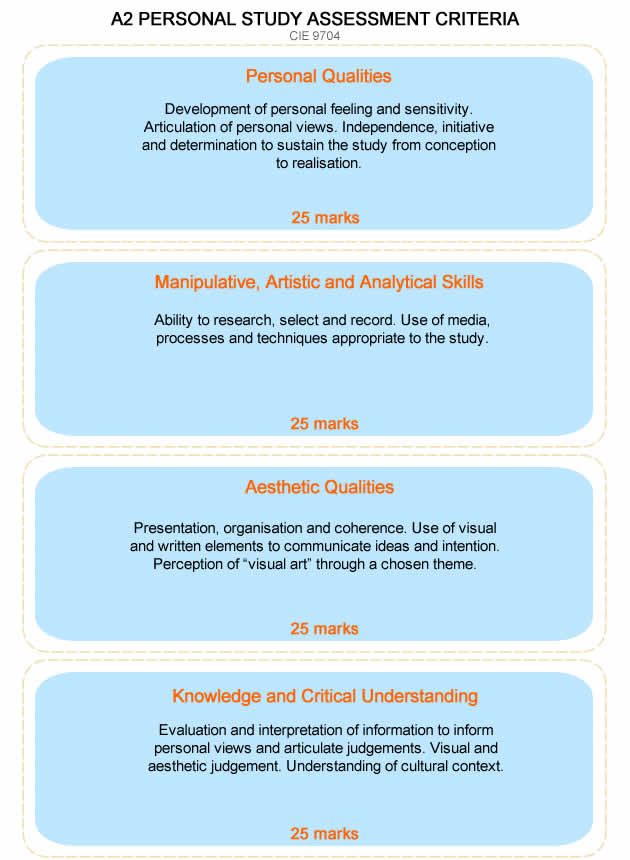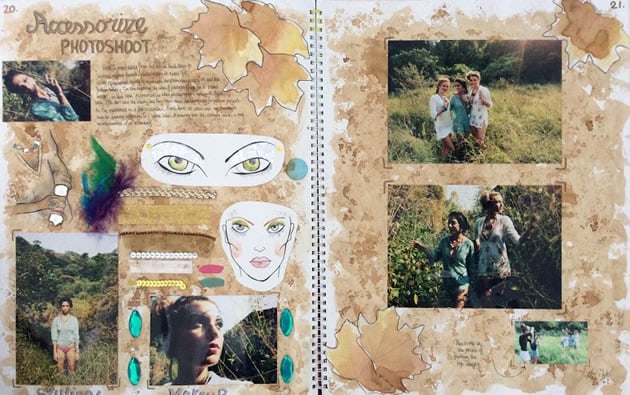Last Updated on September 1, 2023
A2 Art students are required to produce a detailed Personal Study (previously known as the Related Study for CIE students). The Personal Study is a critical and visual appraisal or theoretical study of any aspect of the visual arts. It is usually an analysis of art or design that focuses on one or both of the following:
- Process and materials (the way an artist or group of artists use/s media);
- Subject or theme (the way an artist approaches a similar topic, generally with reference to composition, technique and the visual elements – line, texture, space, colour etc).
It may or may not relate to your AS or A2 Coursework, although a link between the two can be helpful. (This is a new requirement – it used to be that the Personal Study had to relate to Coursework).
Whatever topic is chosen, students must have first-hand access to at least some of the art or design work analysed in their study. It is also beneficial to have access to sketches, planning, incomplete and finished works, so that students are able to understand and illustrate the art-making process. Please read how to select a great A2 Art Personal Study topic for more guidance with this.
Students are required to submit:
- 1 x Personal Study (max 3,500 words, maximum size A1). It may be presented in any appropriate written and/or practical format, including an illustrated formal essay; a structured sequence of annotated art or design work; a presentation of slides; VHS video footage; digital or multimedia presentation (these must be backed up by hardcopy). The Personal Study must include an:
- Introduction
- Conclusion
- Bibliography
Prior to beginning the Personal Study, students should submit a Outline Proposal Form, which details: intentions (the focus of the Study); sources for first-hand study; sources of other information; bibliography; and your teacher’s comments.
A2 Personal Study assessment
The A2 Personal Study is worth 40% of your A2 Art course and 20% of your final A Level Art grade. It is externally assessed (i.e. marked by CIE examiners). Most countries send the Personal Study to Cambridge University to be moderated; other counties, like New Zealand, are lucky enough to have the examiners travel to them.
The Personal Study is given a single mark out of 100, using the following criteria:

Personal Study presentation ideas
CIE gives the following recommendations:
If a balance of visual and written analysis is presented it should not exceed 3500 words. Alternatively, a carefully structured sequence of annotated drawings, paintings, photographs, prints or three-dimensional objects may be presented in any appropriate format. A carefully-ordered slide, tape or video presentation or any combination of written or recorded analysis with any possibility of graphic presentation is also permissible. An introduction, a conclusion and a bibliography are expected to be included in each type of presentation.

In other words, virtually any format is acceptable. Formats that have not been specifically mentioned above include a mounted display or an onscreen presentation, such as a PowerPoint, blog page or vlog (as long as examiners travel to your school for assessment and there are facilities for setting up computers in the moderation and assessment area when the examiners arrive). If you are contemplating a digitally displayed presentation, it is best to seek advice from the examiners prior to beginning your study.
The best personal studies are those that are visually appealing; show artistic and literary skill; communicate a message clearly; and visually complement the artist/s or designer/s studied.

The Personal Study is a substantial project, which cannot be completed at the last minute. Every aspect of the study should be carefully researched and organised. Students must plan and consider the content, order and structure of their study, as well as the presentation methods, including, for example, how they will integrate text and image, as well as selection of font style and colour (the examiners must be able to read the text clearly – if there is any doubt about this, send a typed copy of the text with your submission), text alignment, page format, paper colour and weight, column widths and so on. Illustrations should be exceptionally high quality, relevant to the topic and selected carefully. It is advisable that many of these are hand-crafted or photographed by the student themselves, rather than the majority being second hand images sourced from the internet. Tactile, textured paintings are likely to be better displayed in the flesh, whereas photographic or graphic work may suit a digitally created presentation. Those who are able to create beautiful video footage of an artist working might consider making a DVD. It is worth noting here that while the presentation should be exciting, beautiful and visually interesting, a wildly unusual presentation style is not always necessary – a beautifully composed ‘book’ presentation is more than capable of achieving 100%.
Image (above right) sourced from Tom Wood.
A Level Art Personal Study examples
Below are some examples of some ordinarily presented (yet beautiful) sketchbook layouts, as well as some more creative Personal Studies. I am actively looking to illustrate a wider range here. If you have or know anyone who would be willing to share their work on this website then please read our Featured Art Project submission guidelines.
An A2 Painting / Fine Art Personal Study by Jennifer Neeve from William de Ferrers School:

An A2 Painting / Fine Art Personal Study by Nikau Hindin of ACG Parnell College:


A CIE A Level Art Personal Study by Tirion Jenkins from YMCA of Hong Kong Christian College:

An A Level Art Personal Study by Elizabeth Nicholson from William de Ferrers School:

A Personal Study by Scott Robinson from William de Ferrers School:

A Personal Study by Yantra Scott from William de Ferrers School:

Digital presentation (below right) by Martyn Littlewood:

Note: This article relates to the A2 Personal Study, Component 4, CIE 9704 A Level Art and Design – the International version of A Levels, assessed by the University of Cambridge. Information is sourced from the CIE A Level Art and Design syllabus. It is hoped that the examples of student work will also be of value to students studying A Level Art under other examination boards.
Did you find this article helpful? You might be interested in reading:

